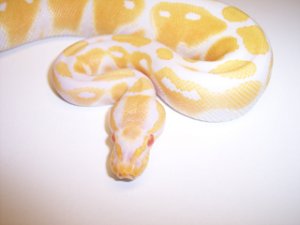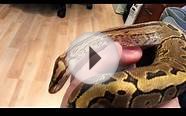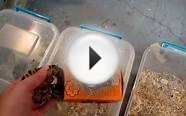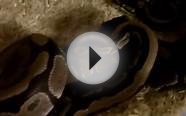Yellow Ball Python
 This is a very common question I’ve seen not only in our ball python forum but in other ball python forums as well. Someone has a ball python that they’ve acquired from a source other than a breeder – pet store, a friend, etc – and they want to know if they’ve miraculously “hit the lottery” and have something other than a normal ball python. The general theme is usually the same, “it looks different, is lighter or darker in color, the pattern looks unique, etc.”
This is a very common question I’ve seen not only in our ball python forum but in other ball python forums as well. Someone has a ball python that they’ve acquired from a source other than a breeder – pet store, a friend, etc – and they want to know if they’ve miraculously “hit the lottery” and have something other than a normal ball python. The general theme is usually the same, “it looks different, is lighter or darker in color, the pattern looks unique, etc.”
Normal or “wild-type” ball pythons are what nature intended ball pythons to look like. They have a combination of dark colors and patterns to help break up their outline so they can camouflage themselves or blend in better with the scenery. This color and pattern ensemble is what helps them succeed in hunting and capturing prey in the wild. Ball python morphs on the other hand are the result of “mutations” in the DNA structure that changes or “morphs” the animals’ physical appearance in such a way that it differs significantly from ordinary normal or wild type ball pythons. These morphs exhibit an unusual color and/or pattern that distinguish them from a normal or wild type ball python. An albino ball python is an excellent reference that comes to mind but there are some morphs that require a trained eye to identity such as the “Yellow belly” ball python for instance.
Albino ball python
Ball pythons originate from varying parts of Africa and some ball pythons have a different look to them that’s based on locale and genetic background. No two ball pythons look exactly alike and no two ball pythons share the same pattern. Some are lighter than others and some have very interesting patterns but they’re all still considered to be normal or wild-type ball pythons, unless otherwise proven differently. The rise in popularity of the ball python morph has caused a massive influx of people wanting to acquire ball python morphs and this level of interest has many people wondering if their “unique looking” normal ball python is more than just a pretty normal ball python.
Most of the ball pythons that people acquire from sources other than a breeder are more than likely imported normal ball pythons. Just like you’re reading my blog right now on the Internet, people in Africa too have Internet access and know about ball python morphs and their values as well. This has caused the exporters in Africa to look over each ball python “with a fine tooth comb” to make sure it’s not a visual morph (i.e. Pastel, Mojave, Lesser Platinum, etc) before preparing them for export as “normal ball pythons”. Once the ball pythons reach the country they’re imported into, the receiver looks at each ball python “with a fine tooth comb” hoping to find a morph that the exporter in Africa missed. They rarely if ever find a morph and if they do, they keep it for themselves or sell it as a morph. The rest of the normal ball pythons are then packed up and sent to pet stores and the like so the odds of receiving something other than a normal ball python from a source other than a breeder is extremely low.
You might also like









